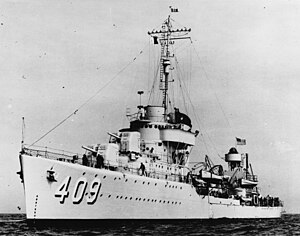Template:Ref improve
 USS Sims (DD-409), lead ship of the class. | |
| Class overview | |
|---|---|
| Name: | Sims class destroyer |
| Builders: |
Bath Iron Works Federal Shipbuilding Newport News Shipbuilding Boston Navy Yard Norfolk Naval Shipyard Charleston Navy Yard Philadelphia Naval Shipyard |
| Operators: |
|
| Preceded by: | Benham-class destroyer |
| Succeeded by: | Benson-class destroyer |
| Built: | 1937–1940 |
| In commission: | 1939–1946 |
| Completed: | 12 |
| Lost: | 5 |
| Retired: | 7 |
| General characteristics | |
| Type: | Destroyer |
| Displacement: |
1,570 tons (standard) 2,465 tons (full load) |
| Length: | 348 ft 4 in |
| Beam: | 36 ft 0 in |
| Draft: | 13 ft 4 in |
| Propulsion: |
|
| Speed: | 37.7 knots |
| Complement: |
|
| Armament: |
|
| Notes: | fuel capacity: 2,929 barrels |
The Sims-class consisted of 12 destroyers in the United States Navy, built in seven various shipyards, and commissioned in 1939 and 1940. It was the last United States destroyer class completed prior to World War II. All Sims-class ships saw action in World War II, and seven survived the war. No ship of this class saw service after 1946.
Of the five ships lost, four were at the hands of the Japanese and one at the hands of the Germans. Three of the seven survivors were undergoing overhauls that were left unfinished at war’s end and ultimately scrapped. The remaining four seaworthy ships were used as targets during the 1946 Operation Crossroads atomic tests at Bikini Atoll. One was sunk by the first blast, while the other three were sunk as targets two years later after serving as experimental platforms.
The Sims class ships were the sixth and final class of the "third-generation" 1500-ton pre-war destroyers that modernized the United States navy in the 1930s. They were the last built with a single engine room, changed with the Benson-class destroyers for increased survivability. However they were also the first increased in hull length, and the precursor for the numerous larger, faster destroyer classes that marked war-time construction.
The Sims class introduced installation of Mark 37 Gun Fire Control System.[1] Distinguished by a turret mounted gun director, the advanced system controlled by a Ford Mark 1 Fire Control Computer mounted deep in the hull enabled automatic aiming of guns against surface or air targets with first-hit solutions in near real-time. The system would evolve and be used extensively to control most 5 inch guns on destroyers and larger ships, and remained in service on US ships until the 1970s.
Early units completed with 12 torpedo tubes (3x4) while later ships completed with 8 (2x2) on the centerline. All were converted to 8-tube configuration before World War II began.

USS Russell (DD-414) in 1943.
Ships in class
| Ship Name | Commissioned | Decommissioned | Fate |
|---|---|---|---|
| Sims (DD-409) | 1 August 1939 | Sunk by Japanese aircraft in the Battle of the Coral Sea, 7 May 1942. (14 survivors). | |
| Hughes (DD-410) | 21 September 1939 | 28 August 1946 | Damaged during Operation Crossroads atomic tests at Bikini Atoll, July 1946. Sunk as target, 16 October 1948. |
| Anderson (DD-411) | 19 May 1939 | 28 August 1946 | Sunk during Operation Crossroads atomic tests (Test "Able"), at Bikini Atoll, 1 July 1946. |
| Hammann (DD-412) | 11 August 1939 | Sunk by Japanese submarine I-168 during the Battle of Midway with the same torpedo spread (salvo) that also sunk the USS Yorktown (CV-5), 6 June 1942. (80 killed). | |
| Mustin (DD-413) | 15 September 1939 | 29 August 1946 | Damaged during Operation Crossroads atomic tests at Bikini Atoll, July 1946. Sunk as target off Kwajalein, 18 April 1948. |
| Russell (DD-414) | 3 November 1939 | 15 November 1945 | Sold for scrap, September 1947. |
| O'Brien (DD-415) | 2 March 1940 | Torpedoed by Japanese submarine I-19, with the same torpedo spread (salvo) which also sunk the USS Wasp (CV-7) and damaged the USS North Carolina (BB-55), 15 September 1942. Sank 19 October 1942 out from Suva while en route to Pearl Harbor for repairs. | |
| Walke (DD-416) | 27 April 1940 | Sunk in Naval Battle of Guadalcanal, 15 November 1942. (88 killed). | |
| Morris (DD-417) | 5 March 1940 | 9 November 1945 | Sold for scrap, 2 August 1947. |
| Roe (DD-418) | 5 January 1940 | 30 October 1945 | Sold for scrap, August 1947. |
| Wainwright (DD-419) | 15 April 1940 | 29 August 1946 | Damaged in the Operation Crossroads atomic tests at Bikini Atoll, July 1946. Sunk as target in Pacific, 5 July 1948. |
| Buck (DD-420) | 15 May 1940 | Sunk by U-616 off Salerno, Italy, 9 October 1943. (150 killed) |
See also
| Wikimedia Commons has media related to Sims class destroyers. |
References
External links
- Sims-class destroyers at Destroyer History Foundation
- Short information about the class
- Tin Can Sailors @ destroyers.org - Sims class destroyer
| |||||||||||
| |||||||||||||||||||||||||||||||||||||||||